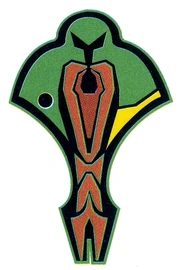
This page details the history of the Cardassians and the Cardassian Union.
The Hebitian Age[]
The first civilization on Cardassia was that of the Hebitians. They were an advanced sophisticated culture on every level, they used solar technologies but also lived in harmony with nature, valuing the soil and living a sustainable self-sufficient life envied by the surrounding planets.
The Hebitian society eventually fell when Cardassia suffered catastrophic climate change, the rainforests and grasslands transformed into desert and scrubland. Disease killed millions; and the survivors formed the militaristic and expansionist society known as the Cardassians. (DS9 novel: A Stitch in Time)
In the year 1345, the Great Starvation begins on Cardassia and saw the end of the Second Hebitian Period. (Last Unicorn RPG module: All Our Yesterdays: The Time Travel Sourcebook)
According to Gary Seven, the Cardassian Union was a peaceful religious plurality in the mid-23rd century. Not long after the destruction of Praxis however, the Union discovered the value of fascism and spread its influence to neighboring worlds within a decade of its discovery. (TOS - Year Five - Experienced in Loss comic: "Issue 23")
In 2376 a jevonite figure was discovered in city of B'hala on Bajor. This find interested Prylar Eivos Calan a great deal, as the material had previously been believed to have been exclusive to Cardassia and quantum dating of the artifact proved it predated the Hebitians. (DS9 novel: Avatar, Book One)
Also that year, Dominion shelling of Cardassia opened the oldest known tomb of the Hebitian Age. The artifacts and art at this site suggest that the first Hebitians were Bajoran, the later Hebitians being Cardassians influenced by Bajoran culture. (New Worlds, New Civilizations short story: "The Glories of the Hebitians")
By the late 24th century, Elim Garak would look upon the pre-Cardassian Union time period as "dark ages." (ST website : The Path to 2409)
Cardassian Union[]
From feudal society to a military state[]
The Cardassian Union was officially declared as a single world government in the year 1591 with Urrent Gar becoming its first de facto ruler. By the year 1670, the Cardassian race had developed warp drive technology. (Last Unicorn RPG module: All Our Yesterdays: The Time Travel Sourcebook)
According to Elim Garak in 2385, early Cardassian society was dominated by very powerful families, which composed the supposed origins of the True Way. A feudal society, there was continual strife between the families. One family was the ancestors of Enabran Tain, who formed the origins of the movement which became the Obsidian Order. The Order was formed to end the strife of the families who ruled Cardassia. As Garak related to Jean-Luc Picard, "It was intended as an instrument of the state: an organization that did not serve a single family, but served them all. The purpose was to put an end to civil war and to provide stability." (The Fall novel: The Crimson Shadow)
The Detapa Council was formed in the year 1870. (Last Unicorn RPG module: All Our Yesterdays: The Time Travel Sourcebook) In addition to this, Cardassian Central Command and the formal structure of the Obsidian Order were jointly established in the 19th century together forming what would eventually be known as the Cardassian Union. (DS9 episode: "Defiant")
The state as it formed was in perpeptual political conflict between factions - with the True Way placing its members in the Detapa Council, the Order and Central Command, to concentrate power in the hands of the great families. Nevertheless, the True Way was the natural enemy of the Order, which was the instrument created to secure the new Cardassian state. (The Fall novel: The Crimson Shadow)
Expansion[]
The Cardassian First Republic existed during the latter part of the 21st century. (DS9 episode: "Destiny")
Tret Akleen was remembered as the "father" of the Cardassian Empire; Akleen was a Cardassian from Ventani II. (DS9 episode: "Tears of the Prophets")
The Cardassians had entered space relatively near to future Federation space as early as the 2150s. One Cardassian became a victim of the automated repair station when he was captured and integrated into the station's computer. Prior to 2154 a Cardassian ship fell victim to a silicon-based virus whilst under observation by the Organians. (ENT episodes: "Dead Stop", "Observer Effect")
In 2167 a Cardassian farmer stumbled upon a Hebitian tomb. (ST short story: "The Glories of the Hebitians") By the year 2169, grave robbers stole many priceless artifacts from the Hebitian burial vaults. (Last Unicorn RPG module: All Our Yesterdays: The Time Travel Sourcebook)
The near bankrupt Cardassian government saw an opportunity and began to excavate other tombs and sell the valuables prizes they unearthed. With there growing riches they financed attacks on neighboring worlds, and won the resources of the worlds they conquered. The attacks rejuvenated the Cardassian people and distracted them from their world's ill state. More and more tombs were unearth and sold and the Cardassian military grew in power. (ST short story: "The Glories of the Hebitians")
At least one Cardassian resided on Vulcan as early as the 2240s. (DS9 episode: "Destiny") In the wake of the Betreka Nebula Incident in the year 2286, a Cardassian-Klingon War erupted which did not end until the year 2304. After the war, the Cardassians begin to establish a "peaceful presence" on Bajor in the year 2309. (Last Unicorn RPG module: All Our Yesterdays: The Time Travel Sourcebook)
- This conflicts with the novel continuity on both the occupation of Bajor and both the date as well as nature of the Betreka Nebula Incident.
By 2328, the Cardassians had been in conflict with the Lissepians, and had encountered members of both the Ferengi Alliance and Orion Syndicate. Also in that year, the Union became involved in the Betreka Nebula Incident, an 18 year long conflict with the Klingon Empire. (TLE novel: The Art of the Impossible) Its also noted that in the same year, the Cardassians forcibly occupy Bajor. (Last Unicorn RPG module: All Our Yesterdays: The Time Travel Sourcebook)
Occupation of Bajor[]
- See main article: Occupation of Bajor.
In 2309, Cardassians first arrived at the planet Bajor, stating a desire to help the Bajoran people. They soon occupied the planet, and by 2328, had officially annexed it. Their occupation of the planet was notoriously cruel, as the Cardassians took the Bajorans' homes, and violated and tortured the people. While occupying the planet, the Cardassians were frequently targeted by terrorist attacks. Although the Federation was not an advocate of this occupation, they did not interfere, as Bajor was within the designated borders of the Cardassian Union. (TNG episode: "Ensign Ro"; DS9 episode: "Emissary")
After spending decades stripping the planet of valuable resources (as well as eight of the nine Bajoran orbs), the Cardassians abandoned Bajor in 2369. As the Cardassians had severely impaired the Bajorans' self-sufficience, Bajoran territory, as well as the mining station Terok Nor, soon came under the protection of the Federation. (DS9 episode: "Emissary") Despite this being the case, the Cardassians did attempt to provide an excuse for a re-invasion of the Bajor system by using the leader of the Redemptionists movement to destroy Deep Space 9 leaving only Gul Gurney's starship the only survivor. In addition, their was an attempt to capture the last of the Bajoran Orbs but this was foiled by the station's Starfleet crew. When confronted about this matter, Gul Skrain Dukat claimed that Gul Gurney was acting without the authority of the Cardassian Union and that his actions were those of a rogue. (DS9 video game: Crossroads of Time)
The Union continued to suffer from Bajoran terrorist attacks, largely perpetrated by the Kohn-Ma faction. (DS9 episode: "Past Prologue")
Conflicts with the Federation[]
- See also: Federation-Cardassian War.
By some accounts, first contact between the Federation and the Cardassian Union occurred circa 2321, on the human colony world of Juhraya. (VOY - The Brave and the Bold, Book Two novella: The Third Artifact)
- This conflicts with Day of the Vipers, which states that the Cardassians were already engaged in "pointless, unresolved conflicts" with the Federation by 2318. This implies a first contact date sometime before or during 2318. According to Unspoken Truth, the Federation was already aware of the Cardassians prior to 2286, as the residents of the Iadara Colony were "toughened" by being so close to Cardassian space.
The first official talks between the Cardassians and the Federation took place in 2327, however the Cardassians were using the talks as a pretense to disrupt relations between the Federation and Legarans to make Legara IV susceptible to annexation by the Cardassians. Fortunately the plan was uncovered and the Federation placed extra Starfleet protection around Legara. (TOS comic: "Enter the Wolves")
In the 2330s, a tense stalemate existed between the Cardassian Union and the Federation, especially in the "Oblivion" sector, where tensions between the two powers and the bordering Ubarrak Primacy were high. (STA novel: Oblivion)
The Cardassian Union engaged in a war against the United Federation of Planets for at least a decade; the hostilities began in earnest in 2355. The Cardassians rejected at least one offer, made by Captain Jean-Luc Picard, to end the conflict diplomatically. One infamous conflict of the war was the Setlik III Massacre. The war finally ended in 2366 (circa stardate 43400). A treaty was signed, but the Cardassians upheld a strong military presence along the border, which included several innocuous-looking starships and facilities that were really serving covert purposes. For some time, it was not considered wise to "stay too long on a Cardassian border without making your intentions known." (TNG episode: "The Wounded"; TNG video game: Echoes from the Past)
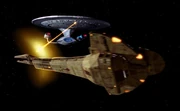
The Enterprise and the CDS Trager, in 2367
Hundreds of thousands of Cardassian citizens were killed during the war, which had a very demoralizing impact on the people of the Union. The Union's food supplies were also depleted. (TNG episode: "Chain of Command")
In 2367 (circa stardate 44400), an armistice was reached between the Union and the Federation; Edward Jellico was among those who helped to negotiate. The armistice resulted in several disputed territories being ceded to both parties, with allowances for further negotiations. Another diplomatic resolution between the two powers was the Seldonis IV Convention, which related to the treatment of prisoners. (TNG episode: "Chain of Command")
Shortly after the armistice was signed, two days before stardate 44429.6, the USS Phoenix destroyed a Cardassian outpost in the Cuellar system (sector 21505). Many Cardassians assumed this to be an undeclared rebirth of the war, and reacted accordingly. However, it was an isolated incident, which was resolved by Captain Picard and Chief Miles O'Brien of the USS Enterprise. During this incident, the Cardassians gained the ability to read Starfleet transponder codes; Starfleet was already capable of reading Cardassian codes. The Cardassian death toll from the actions of the Phoenix numbered over seven hundred. (TNG episode: "The Wounded")
Months later, on stardate 45076.3, Cardassian ships attacked a Federation colony on Solarion IV. The Bajoran terrorist Orta was implicated, and a Cardassian liaison met discreetly with Starfleet's Admiral Kennelly to discuss ways of eliminating Orta's threat. Two Galor-class warships intercepted the USS Enterprise in the Valo system while she was escorting a ship carrying Orta home; the Cardassians destroyed Orta's ship, only to find that the escort had been staged, and the ship empty. The Cardassians' duplicity was discovered, and they returned home. (TNG episode: "Ensign Ro")
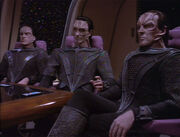
The Cardassian delegation to the Enterprise, in 2369.
After the Cardassian withdrawal from Bajor in 2369, many forces were redeployed along the Federation border. The Union intended to take possession of several territories that had been ceded to the Federation by the armistice. On stardate 46358, a Cardassian delegation led by Gul Lemec of the Reklar met with Captain Jellico of the Enterprise to negotiate a Federation withdrawal from the border. A Cardassian fleet was stationed in the McAllister Nebula, waiting to attack should it become necessary. Meanwhile, the Cardassians carried off an elaborate ruse involving metagenic weapon signatures on Celtris III for the purposes of capturing Jean-Luc Picard, who would have a pivotal role in the Federation defense plans, should a conflict ignite. A team from the Enterprise surreptitiously mined the Cardassian fleet, and the Union was forced to withdraw and return Picard. (TNG episode: "Chain of Command")
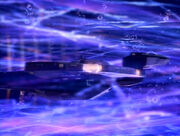
The first Cardassian voyage into the Bajoran wormhole.
The Union had another close call with the Federation days later, when the Bajoran wormhole was discovered. A ship commanded by Gul Dukat entered the wormhole to negotiate for Prophet technology, and was immediately lost when the wormhole disappeared. The Seventh Order, under the command of Gul Jasad, came looking for Dukat and was unwilling to believe the story of the wormhole's temporary existence. Jasad traded shots with Major Kira Nerys of Deep Space 9 before the wormhole reappeared. Although the system had once again become a valuable commodity, the Cardassians departed after witnessing Dukat's ship saved by Commander Benjamin Sisko. (DS9 episode: "Emissary")
The discovery of the wormhole renewed the Union's interest in possessing Bajoran territory. In 2370, the Cardassians secretly supplied the Alliance for Global Unity, an anti-Federation political movement on Bajor, with weapons. However, The Alliance's political strength was undermined when news of the Cardassians' involvement was spread. (DS9 episode: "The Circle")
Not long after that, in 2370 the Revanche party came to power in Cardassia, they wanted to reoccupy Bajor. (DS9 novel: Betrayal)
After the fall of the Obsidian Order a civilian uprising wanted to change the government of Cardassia. Gul Dukat was called back to Cardassia Prime to be the final guard of the military. In the same time, the main fleet of the Cardassian military was destroyed by the Hive. (DS9 novel: Objective: Bajor)
Civilian uprising[]
In response to the fear of changeling infiltration sparked by initial contacts with the Dominion in 2371, the Cardassian Union sealed their borders. As a result, other powers in the region, such as the Federation and the Klingon Empire, had limited information coming from Cardassian space. However, reports that a civilian uprising had overthrown the Central Command to instate the Detapa Council as the ruling body did succeed in making it into Federation and Klingon hands.
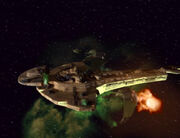
Klingons destroying the CDS Prakesh.
The Klingons, already restless for battle, believed this to be due to the influence of the Dominion. They sent a fleet of vessels to Deep Space 9 with the intent of invading Cardassian space. Though the Federation condemned the action, they couldn't officially warn the Cardassians, though Captain Benjamin Sisko of Deep Space 9 leaked this information to them through Garak, and later rescued the leaders of the Detapa Council with the USS Defiant. Though the belief that the government had been infiltrated by changelings proved incorrect, it led to an increased state of tensions between the Klingons and Cardassians for the next year and a half. (DS9 episode: "The Way of the Warrior")
- For more information, see Klingon-Cardassian War of 2371.
The Detapa Council remained in control of the Cardassian government until the Union joined the Dominion in mid-2373. (DS9 episode: "In Purgatory's Shadow")
Dominion War[]
- See also Dominion War.
Due in part to continued hostilities with the Klingons, as well as Maquis activities in the Demilitarized Zone between Federation and Cardassian space, the Detapa Council opened negotiations with the Dominion, with Gul Dukat heading the negotiations. Through Dukat's mediation, the Cardassian Union surprised the Alpha Quadrant and joined the Dominion in mid-2373. The Dominion sent a fleet of some fifty ships through the Bajoran wormhole and entered Cardassian space. (DS9 episode: "In Purgatory's Shadow")
Dukat, the newly appointed leader of the Union, promised to retake all that had once belonged to Cardassia. Over the next few days, the Dominion forces successfully forced the Klingons from Cardassian territory and all but wiped out the Maquis. The new threat caused the restoration of the Khitomer Accords between the Federation and the Klingons, and brought together a joint Federation-Klingon-Romulan fleet at Deep Space 9. The Dominion was nearly successful in destroying this entire fleet when a changeling impersonating Dr. Julian Bashir tried to destroy the Bajoran sun. He was stopped by station personnel, however, and war was temporarily averted. (DS9 episode: "By Inferno's Light")
Over the next few months, obstacles to Cardassians desire to expand their borders were removed as the Dominion signed nonaggression pacts with the Miradorn, the Tholian Assembly, and most notably the Romulan Star Empire. New fleets of Dominion ships also arrived from the Gamma Quadrant every week, bringing Cardassia back to its earlier strength.
In late 2373, the Federation finally decided to prevent the Dominion threat from gaining more strength, and mined the Bajoran wormhole. This marked the beginning of the Dominion War, as a Dominion-Cardassian fleet attacked and occupied Deep Space 9, but not before the minefield was in place. (DS9 episode: "Call to Arms")
Over the next few months, the Cardassians and Dominion won battle after battle against the Federation-Klingon forces. With reinforcements from the Gamma Quadrant still unable to get through, they could not achieve the victory as quickly as they wished. This looked to change as Gul Corat Damar, an aide to Dukat, found a way to detonate the entire minefield. (DS9 episodes: "Call to Arms", "Behind the Lines")
The Federation attempted to prevent this by launching an attack toward the station in Operation Return, but the minefield was detonated before the fleet could arrive. The Dominion forces poured into the wormhole, facing only the USS Defiant. As the Defiant's crew prepared for a hopeless battle, the Bajoran Prophets contacted their Emissary, Benjamin Sisko, and destroyed the entire fleet to save Sisko's life. Without the reinforcements, the Federation Alliance fleet was victorious, and the Dominion and Cardassian forces withdrew into Cardassian space. (DS9 episodes: "Favor the Bold", "Sacrifice of Angels")
With the loss of reinforcements from the Gamma Quadrant, the Cardassian ruling elite began operations in 2374 to find a means of producing artificial wormholes in order to re-establish their supply link to their Dominion allies. This resulted in numerous scientific missions to study Badlands-type phenomena in order to seek a means of creating a stable wormhole. (TOS novel: Spectre)
At the very end of the war the Cardassians turned on their Dominion overlords, thus turning the tides in the final battle of war, allowing the Federation allied fleet to make it all the way to Cardassia and end the conflict. Unfortunately in those final moments, the Cardassian's treachery also earned them Dominion retribution as the Jem'Hadar attempted to wipe them out, killing 800 million of the people and reducing Cardassia to a smoldering wreck. (DS9 episode: "What You Leave Behind")
Post-war recovery and allied occupation[]
Following the Dominion War, the Cardassian Union was occupied by the Federation, as well as the Klingon and Romulan Empires.
On Cardassia life was hard, at the place were Enabran Tain's house once stood Elim Garak returned to make his home. There he built a memorial to his dead mother buried in the rubble which became an icon to the local people and the site of a flashpoint between growing political movements in the site; the democratic Reunion Project led by Alon Ghemor and the more traditionalist Directorate. The two parties eventually agreed to compete in a ballot which the Reunion Project won, taking four out of the six sectors of Cardassia City. (DS9 novel: A Stitch in Time)
In 2376 Cardassian Union forces attempted to negotiate with the Ferengi in order to gain access to the omega molecule. The endeavor was brought to an end when Romulan forces under Admiral Sela took possession of the molecule. (TNG video game: Armada)
The following year Gul Kentar, with the logistical support of the Romulan Star Empire secretly built up the Union's military forces. The forces under Kentar developed a new technology for Kulinor-class vessels allowing them to open a quantum singularity and summon a Species 8472 frigate into normal space.
Around the same time, the Borg launched a new incursion into the Alpha Quadrant, which Starfleet responded to by launching a counter strike that put the bulk of Starfleet forces in the Delta Quadrant. Kentar saw an opportunity and made his first strike, destroying the Federation reserve fleet stationed in the Pearl Nebula. The attack provoked the Klingon Empire to launch a campaign against Kentar's forces in revenge for his cowardly attack on their allies. The Klingon fleet took on Cardassian forces in a succession of systems and eventually learned Kentar's fleet was being supported by the Romulans - in response the Klingon obliterated Romulan supply convoys in the Mornaur system, weakening Kentar's ability to maintain his forces. The Klingons eventually pushed Kentar's rebellion back into Cardassian system and took control of Cardassia Prime. While the Cardassian leadership sought a truce with the Klingons, Kentar fled to his last stronghold in the Hurik system. Martok's forces followed and swiftly destroyed the remainder of the rebellion, including the quantum singularity research center and Kentar's vessel. (ST video game: Armada II)
32nd century[]
By the late 32nd century at least one Cardassian was serving in Starfleet, with a female Cardassian Captain present at a briefing given by Fleet admiral Charles Vance. (DSC episode: "Scavengers")
In 3190, Laira Rillak a female with Cardassian, Human, and Bajoran ancestry became President of the United Federation of Planets. (DSC episode: "Kobayashi Maru")
Alternate realities[]
In a parallel universe visited by Worf in 2370, the Cardassian Empire was overthrown by the Bajorans. In this same universe, a Cardassian served as the conn officer of the USS Enterprise, suggesting an alliance between the Empire and the Federation. (TNG episode: "Parallels")
In an alternate continuity caused by the apparent death of Benjamin Sisko in 2372, the Cardassians entered into a mutual defense pact with the Bajorans, to defend against the Klingon Empire. (DS9 episode: "The Visitor")
In one alternate timeline, Bajor was never liberated from Cardassian control who managed to retain dominance over the Bajoran race through their station Terok Nor. Their extended control over the system led the Cardassian Union to discover the Bajoran wormhole and after discovering such a stable passageway that led to the Gamma Quadrant, they classified its existence to only their highest leaders preventing the other interstellar governments from knowing of its existence. Through their explorations and partnership with the Ferengi Alliance, they learnt of the Dominion and formed an alliance with the Founders who agreed to conquer the Alpha Quadrant. This began a covert campaign where Changelings were dispatched to take over high ranking positions in the Federation, Klingon and Romulan governments whereupon they used their identities to spark a war that would weaken all three powers allowing for the Dominion to easily conquer them. This was followed by increased Cardassian aggression on the Federation border as well as equipping a number of Cardassian ships with polaron based weaponry. However, their plans were discovered by the Federation when Bajoran terrorist Kira Nerys, Ferengi Quark and rogue Changeling Odo revealed the truth of the Dominion involvement. This was followed by the USS Enterprise traveling under cloak into the Bajor system and destroying the wormhole thus severing the Cardassian from their Dominion allies. (DS9 novel: A Gutted World)
In one alterate timeline set after 2375 which was created by the formation of the red wormhole and the star of the War of the Prophets; the Cardassian Union and its people would be destroyed by the Grigari and the Bajoran Ascendancy. The Hub worlds and the Union Territories would be destroyed and by the year 2400 there was nothing left of the Union beyond scattered groups of mercenaries, refugees and madmen. (DS9 - Millennium novel: The War of the Prophets)
Connections[]
- Cardassian history article at Memory Alpha, the wiki for canon Star Trek.
